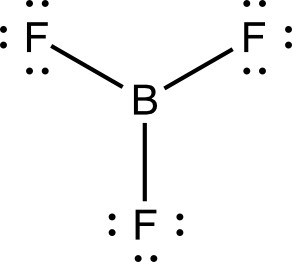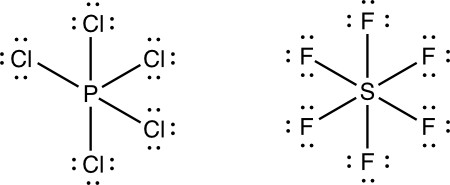When drawing Lewis structures, there are several exceptions to the octet rule. There are radical species, species that form less than three bonds, and expanded valence shells.
Radical Species Most compounds have an even number of valence electrons. There are some exceptions, like NO2. The total number of valence electrons is 5 for nitrogen plus 12 for oxygen which equals 17 valence electrons. The Lewis structure for NO2 is below.
There is an unpaired electron on the nitrogen atom. Any species with an unpaired electron is a free radical. Radicals are highly reactive and can damage body tissues and cells because they will take electrons wherever they can get them. This is why we take antioxidants, like vitamin C, that provide electrons, in the form of hydride ion, to the free radicals. Free radicals are also important in the combustion of fuel, and in the preparation of polymers.
Species that are electron poor. The Lewis structure for BF3 is shown below.
The boron atom only has three valence electrons and can only form 3 bonds. It cannot achieve an octet. Boron will react with other compounds because there is an empty p orbital that can accept a pair of electrons.
Expanded Valence Shells
Elements below the second period can accomodate more than an octet of electrons. For example, phosphorous can form either PCl3 or PCl5. The phosphorous atom in PCl5 has 10 electrons surrounding it. In SF6, the sulfur atom can accommodate 12 electrons because it is in the third period. Recall, the second period elements can only accommodate up to 8 electrons where in the third period there are the empty d orbitals meaning an atom can accommodate more than an octet of electrons. The Lewis structures for both PCl5 and SF6 are shown below.
Both of these are valid Lewis structures. The octet rule only applies to those elements in the second period.
Exercises
Exercise 1. Draw a Lewis structure for ClO2.
Exercise 2. Draw a Lewis structure for I3–.
Exercise 3. Draw a Lewis structure for XeF4.
Exercise 4. Draw a Lewis structure for ClO2–.
Exercise 5. Draw a Lewis structure for BH3.
Exercise 6. Draw a Lewis structure for SeCl2.
Exercise 7. Draw a Lewis structure for NO2–.
Check Solutions/Answers to Exercises
Back to Covalent Bonds and Lewis Dot Structures
Back to General Chemistry 1 Study Guides
Back to Home Page


